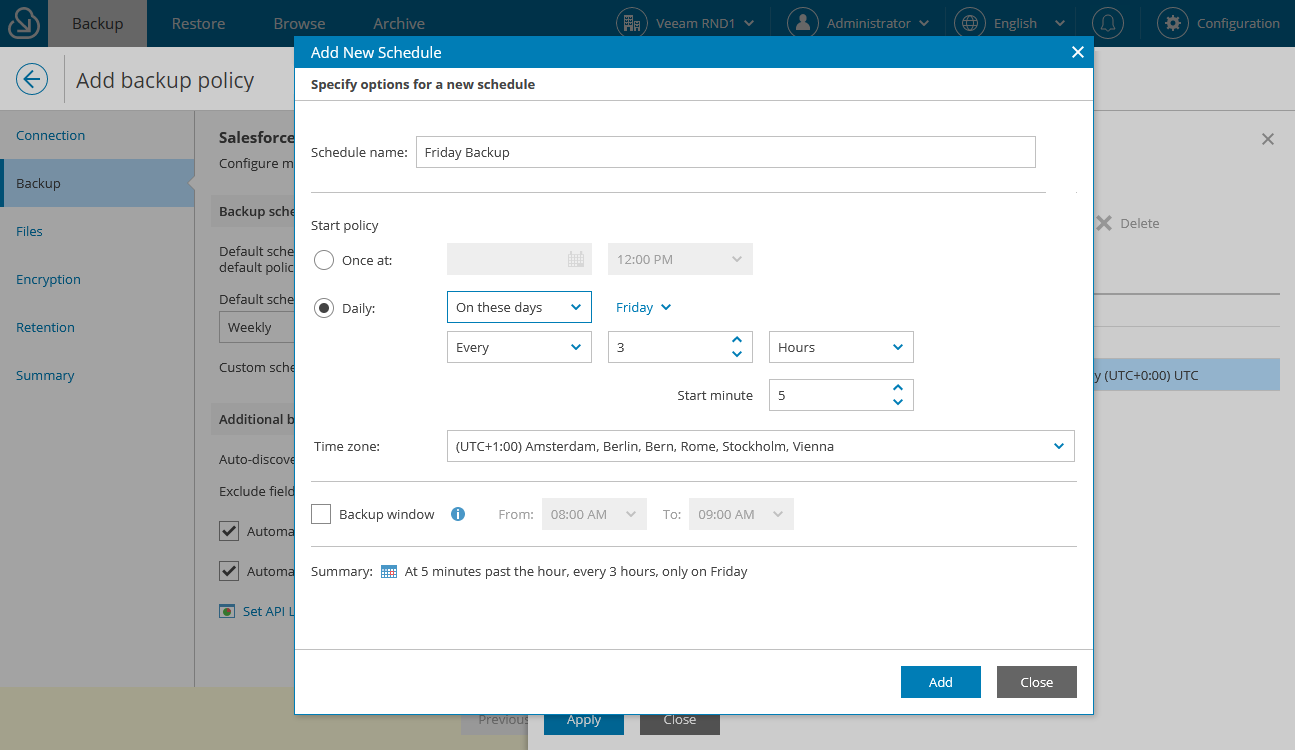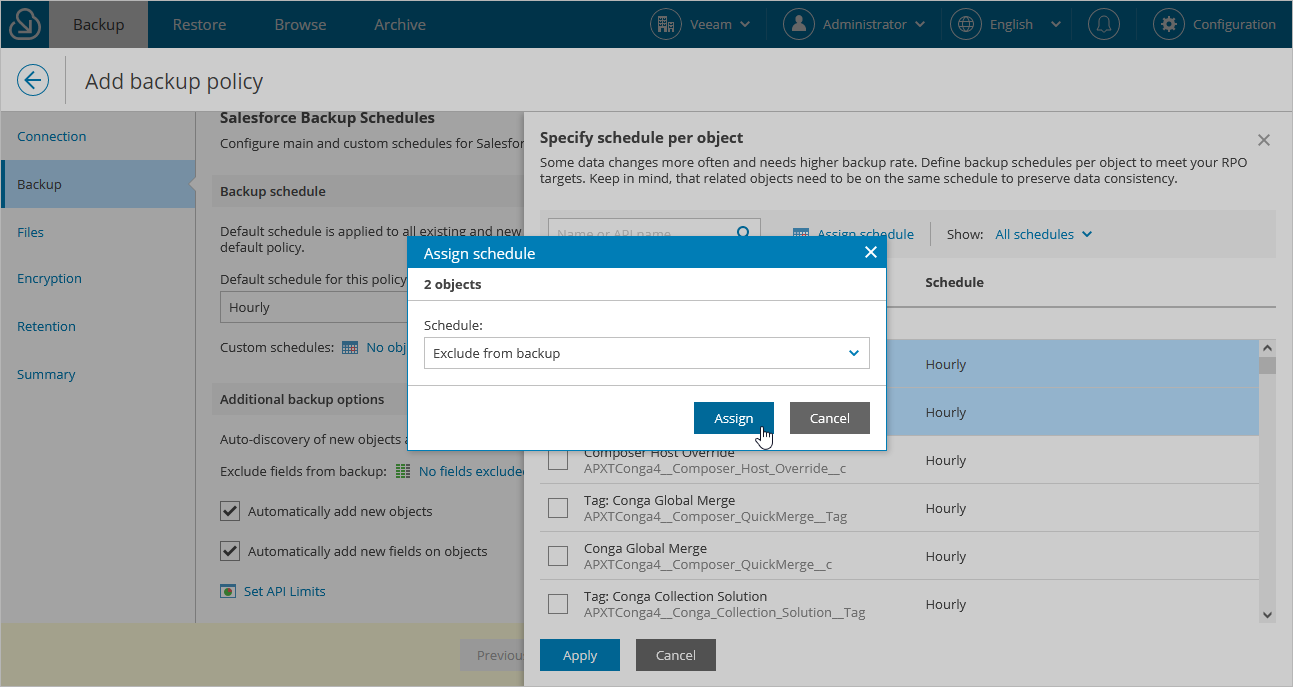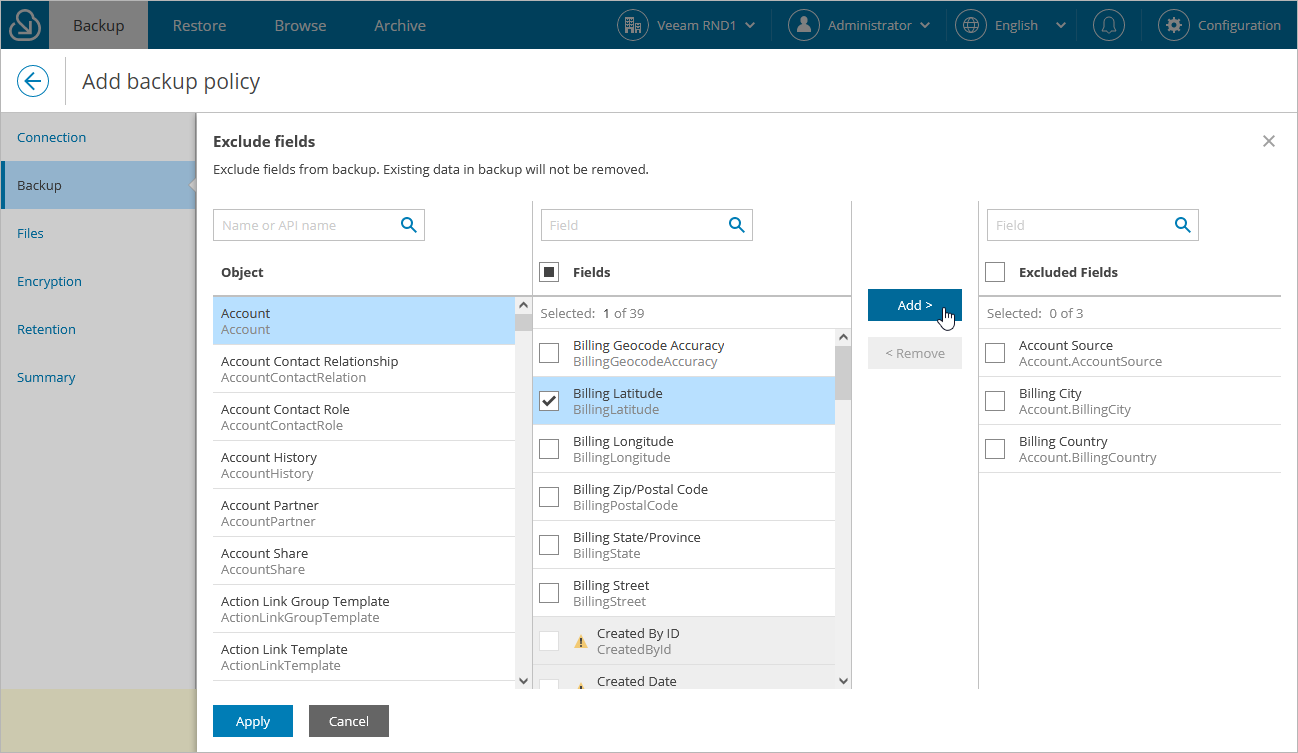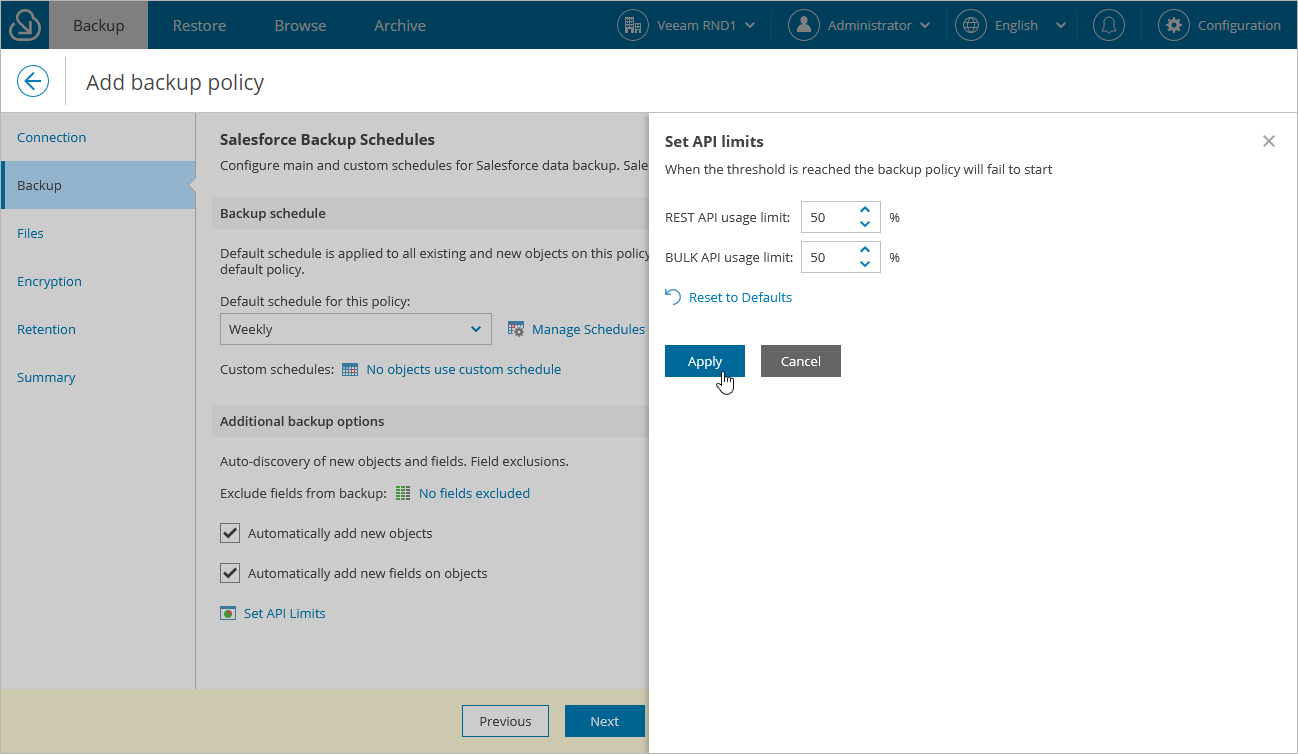Step 3. Configure Backup Settings
At the Backup step of the wizard, specify schedules according to which Veeam Backup for Salesforce will launch policy sessions, exclude object fields from the backup scope, instruct Veeam Backup for Salesforce to automatically add new objects and fields to the policy, and limit API calls sent by Veeam Backup for Salesforce to Salesforce.
Step 3a. Configure Backup Schedules
In the Backup schedule section, configure default and custom schedules for the backup policy. Veeam Backup for Salesforce has 3 built-in schedules:
- Hourly — this schedule launches a backup policy session at the beginning of every hour.
- Daily — this schedule launches a backup policy session every day at 00:00 UTC.
- Weekly — this schedule launches a backup policy session every Sunday at 00:00 UTC.
Note |
You cannot edit or remove the built-in schedules. If none of the built-in schedules meets your business needs, you can create a new schedule as described in section Specifying Default Schedule for Backup Policy. |
Specifying Default Schedule for Backup Policy
From the Default schedule for this policy drop-down list, select a default schedule that will be used to back up data of all objects of the protected organization that have no custom schedules assigned, to back up object metadata, to back up files and attachments if you specify any at step 4, and to back up new objects and fields if you select this option in the Additional backup options section. You can select one of the built-in schedules or create a new one.
Important |
If you plan to run multiple backup policies at the same time, it is recommended that you add at least 256 MB of RAM per one backup schedule. |
To create a new schedule for the backup policy, do the following:
- In the Backup schedule section, click Manage Schedules.
- In the Manage Schedules window, click Add New Schedule.
- In the Add New Schedule window, do the following:
- In the Schedule name field, specify a name for the schedule. The name must be unique for the company selected at step 1.
- In the Start policy section, select the schedule type:
- To run a backup policy once, select the Once at option and specify the time when the backup policy must run.
Note that you cannot combine one-time schedules with periodic schedules when configuring the default schedule and custom schedules for backup policy. If you select the Once at type of schedule as the default policy schedule, you must manually remove all periodic schedules configured for Salesforce objects, wait for the policy session to complete, and then re-configure periodic schedules for the policy.
- To run a backup policy periodically, select the Daily option and specify how often you want Veeam Backup for Salesforce to run the policy.
Note |
The configured schedules are stored in the CRON format and used to run policy sessions. If you specify to run a session every 9 hours, Veeam Backup for Salesforce will follow the following schedule (UTC): Mon 00:00, Mon 09:00, Mon 18:00, Tue 00:00, Tue 09:00, Tue 18:00 and so on. |
- [Applies if you have selected the Daily option] If you want the backup policy to run only during the specific period of time, select the Backup window check box and specify the time interval.
- From the Time zone drop-down list, select a UTC time offset. By default, the time zone of your browser is selected.
- Review the settings and click Add.
The created schedule will be available in all backup policies created for Salesforce organizations within one company. You can further edit or delete these schedules.
Important |
|
Specifying Custom Schedules for Protected Objects
If some objects are updated frequently and need to be backed up more or less often than other objects belonging to the protected Salesforce organization, you can assign custom schedules to these objects. Veeam Backup for Salesforce will launch a separate backup session to protect each group of objects according to the assigned schedule. It is recommended that you assign the same schedule to the related Salesforce objects to ensure that these objects can be restored properly.
To assign a schedule to an object, do the following:
- Click the link in the Custom schedules field.
- In the Specify schedule per object window, do the following:
- In the Object list, select check boxes next to the objects that must be protected according to a specific schedule.
- Click Assign schedule, choose the necessary schedule from the Schedule drop-down list in the Assign schedule window, and click Assign.
Tip |
By default, Veeam Backup for Salesforce backs up all supported Salesforce objects of the protected organization. However, some Salesforce objects cannot be restored, such as history objects. If you do not want to back up these or any other objects of the organization, you can exclude them from the backup policy. To do that, select the Exclude from backup option from the Schedule drop-down list. Salesforce objects that are not backed up by Veeam Backup for Salesforce are listed in Appendix A. Unsupported Objects. |
- Click Apply to save the changes.
Note |
By design, the User and Organization objects are automatically added to every schedule configured for the backup policy. You cannot exclude these objects manually. |
Note that Veeam Backup for Salesforce prioritizes custom schedules over default schedules. If you assign a custom schedule to an object, the product will ignore the selected default schedule and will back up this object according to the custom schedule only.
Step 3b. Configure Additional Options
In the Additional backup options section, you can specify data protection settings and limit the API requests.
When you create a backup policy for a Salesforce organization, Veeam Backup for Salesforce automatically adds all its objects, records and fields to the backup scope.To specify additional data protection options, do the following:
- To exclude specific fields from the backup scope, click the link in the Exclude fields from backup field and select the necessary fields.
- To automatically protect new objects added to the Salesforce organization, select the Automatically add new objects check box.
- To automatically protect new fields, select the Automatically add new fields on objects check box.
The total number of API requests that can be sent to Salesforce within 24 hours is limited for each Salesforce organization. To ensure that Veeam Backup for Salesforce does not conflict with other applications that use API requests for integration with Salesforce, it is strongly recommended that you specify thresholds for REST API and BULK API requests that must not be breached during backup operations. For more information on the API request limits, see Salesforce Documentation.
By design, Veeam Backup for Salesforce checks the number of remaining API requests every time it starts a new policy session:
- If any of the specified thresholds is breached, the session fails with an error indicating that the API request limit has been exceeded.
- If none of the specified thresholds is breached, Veeam Backup for Salesforce starts processing objects added to the policy one by one.
Every time it processes a new object, it checks the number of remaining API requests — if any of the specified thresholds is breached, the session fails with an error indicating that the API request limit has been exceeded, and all objects that have not been processed yet remain unprotected. However, Veeam Backup for Salesforce continues sending requests to Salesforce to back up objects whose processing started before the session failed. The latter may cause Veeam Backup for Salesforce to accidentally exceed the maximum limit of API requests that you specified.
To specify the REST API and BULK API request thresholds, click Set API Limits and enter the necessary threshold values (in percentage) in the Set API limits window.



